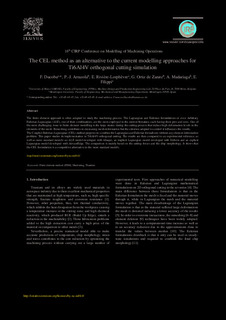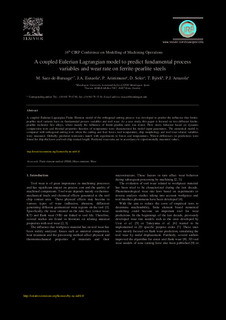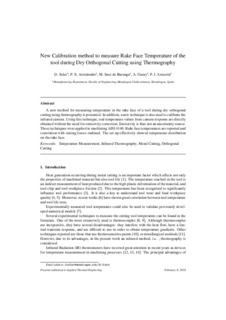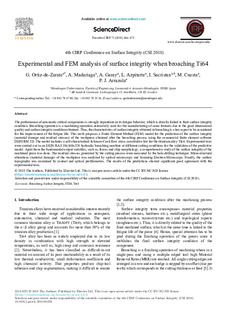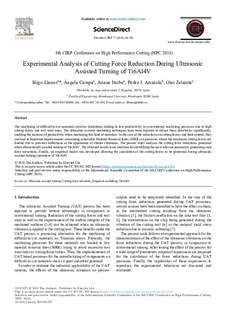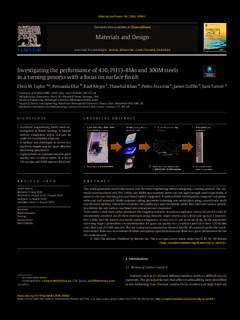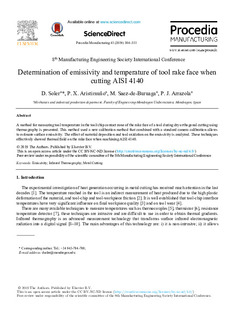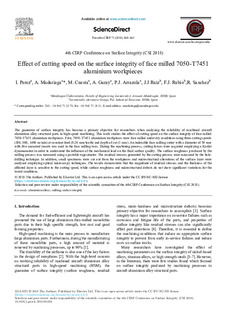Bilatu
102-tik 1-10 emaitza erakusten
Influence of Microstructure on Chip Formation when Broaching Ferritic-Pearlitic Steels
(Elsevier B.V., 2017)
Broaching is a specific process characterized by relatively low cutting speeds and uncut chip thicknesses. The latter is in the range of 0.1 to 0.25 mm in the roughing section of the tool but can decrease down to 0.0015 ...
The CEL Method as an Alternative to the Current Modelling Approaches for Ti6Al4V Orthogonal Cutting Simulation
(Elsevier B.V., 2017)
The finite element approach is often adopted to study the machining process. The Lagrangian and Eulerian formulations or even Arbitrary Eulerian-Lagrangian (ALE), one of their combinations, are the most employed in the ...
A Coupled Eulerian Lagrangian Model to Predict Fundamental Process Variables and Wear Rate on Ferrite-pearlite Steels
(Elsevier B.V., 2017)
A coupled Eulerian-Lagrangian Finite Element model of the orthogonal cutting process was developed to predict the influence that ferritepearlite steel variants have on fundamental process variables and tool wear. As a case ...
New Calibration method to measure Rake Face Temperature of the tool during Dry Orthogonal Cutting using Thermography
(Elsevier Ltd., 2018)
A new method for measuring temperature in the rake face of a tool during dry orthogonal cutting using ther-
mography is presented. In addition, a new technique is also used to calibrate the infrared camera. Using ...
Experimental and FEM analysis of surface integrity when broaching Ti64
(Elsevier, 2018)
The performance of aeronautic critical components is strongly dependent on its fatigue behavior, which is directly linked to their surface integrity condition. Broaching operation is a machining operation extensively used ...
Experimental analysis of cutting force reduction during ultrasonic assisted turning of Ti6Al4V
(Elsevier Ltd., 2019)
The machining of difficult-to-cut materials involves limitations leading to low productivity in conventional machining processes due to high cutting forces and tool wear rates. The ultrasonic ...
Investigating the performance of 410, PH13-8Mo and 300M steelsin a turning process with a focus on surfacefinish
(Elsevier Ltd., 2020)
This study generated novel behavioural data for three engineering steels undergoing a turning process. The materialswere hardened 410, PH13-8Mo and 300M, two stainless steels and one high strength steel respectively. A ...
Determination of emissivity and temperature of tool rake face when cutting AISI 4140
(Elsevier B.V., 2019)
A method for measuring tool temperature in the tool/chip contact zone of the rake face of a tool during dry orthogonal cutting using thermography is presented. This method used a new calibration method that combined with ...
Estimación cualitativa de la rugosidad mediante algoritmos de aprendizaje automático en una operación de taladradoQualitative estimation of the roughness using automatic learning algorithms in a drilling operation
(Federación de Asociaciones de Ingenieros Industriales de España, 2020)
Effect of cutting speed on the surface integrity of face milled 7050-T7451 aluminium workpieces
(Elsevier Ltd., 2018)
The guarantee of surface integrity has become a primary objective for researchers when analysing the reliability of machined aircraft aluminium alloy structural parts in high-speed machining. This work studies the effect ...



